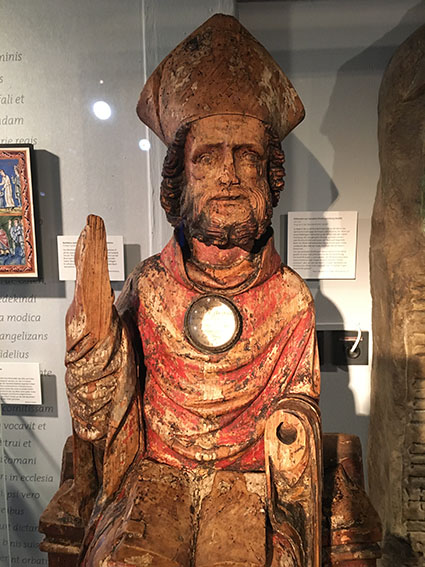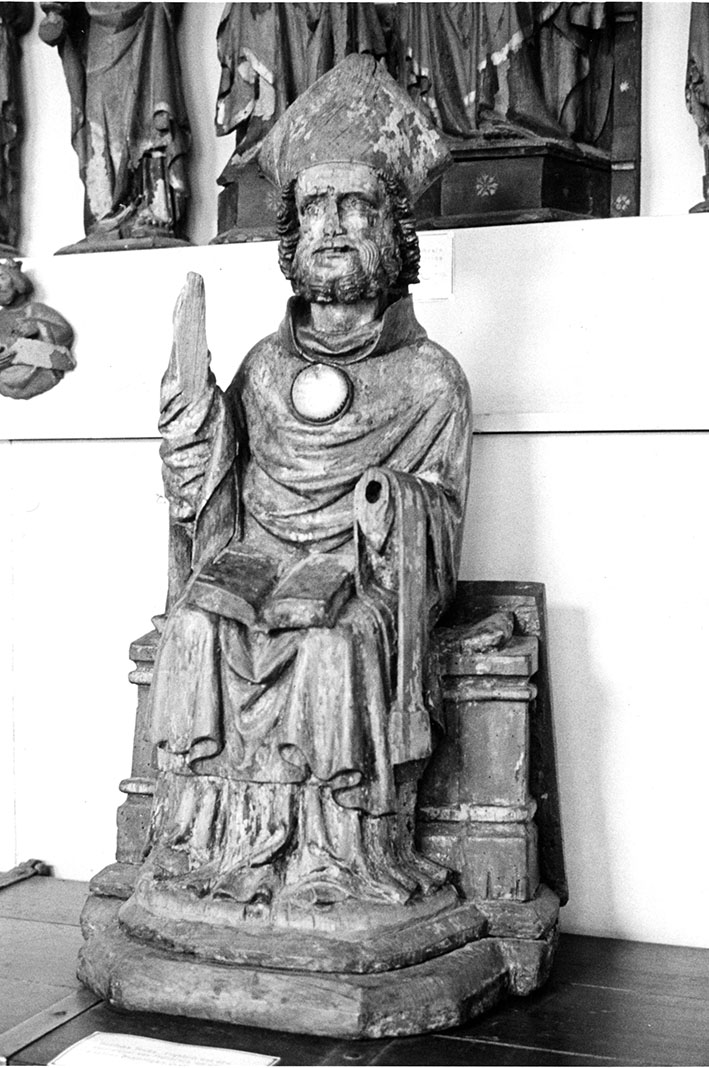
St. Boniface, © Museum Hameln
Boniface – or another?
This Gothic wooden sculpture is considered to represent St. Boniface. It comes from the Hamelin Minster, which has been the patron saint of the pagan missionary Bonifatius since the middle of the 13th century. The throne bishop is traditionally assigned to St. Boniface. Does this assignment stand up to today’s scientific knowledge?
The existing external features – the book, the episcopal robe and the miter, the bishop’s cap – are also used in other sculptures by bishops. An identification of the person based on the individual facial features – as with most medieval representations of saints – is not possible. Because the 14th century sculptor is not concerned with the realistic reproduction of the 754 deceased missionary Boniface. Instead, figures of saints like these always show ideal figures that correspond to the sense of beauty and fashion of the time in which the portrait was created. The figure represents a dignified bishop saint in the typical chasuble of the 14th century. The basic form of the miter shown here as a double cap only exists since the 11th century. Boniface himself never wore a miter.
Nevertheless, current research assumes that the sculpture shows St. Boniface.

St. Boniface, © Museum Hameln
Participation in divine salvation – faith and relic worship in the Middle Ages
This wooden sculpture is not only a pictorial representation of a saint, but also served as a reliquary, as a storage container for relics: in the chest area of the figure there is a cavity that is closed with a semicircular rock crystal. Behind this transparent stone is a list of relics.
But what are relics anyway?
Preserved body parts of a saint, such as bones, hair or fingernails, can be used as relics, but also objects that a saint touched during his lifetime, such as clothing. Things that came into contact with the body after the saint’s death can also be declared relics.
Relics associated with people who were close to Jesus Christ are considered particularly valuable. Objects with which Jesus himself came into contact, such as fragments of the cross, are of paramount importance. Such a chip from the cross of Christ is said to have been in this figure. In addition, relics of seven saints, including the apostles Simon Peter and Squidward, have been preserved in this sculpture.
What are these relics for? Saints are seen in the Catholic faith as particularly exemplary Christian people and as mediators to God. The adoration of a saint or even the magical invocation of his earthly legacies is strictly prohibited in the Catholic Church. Believers seek a relic to feel close to the saint and to intercede for a saint to assure themselves of God’s presence.
With the medieval hope of relics being miraculous, not only pilgrimage is flourishing, but also the trade in relics – although the Roman Catholic Church has repeatedly prohibited such transactions. The reformers‘ criticism of the old church is also directed against such excesses.
In many places during the Protestant iconoclasm relics are looted, destroyed or banished from the churches. Not so in Hameln, where the Reformation in the 16th century prevailed relatively undramatically for several decades. The canons also joined the Evangelical Lutheran faith until 1576. However, the sculpture of St. Boniface still had an important function, which came from the Roman Catholic tradition, until the abolition of the canon in 1850: the meetings of the foundation leadership can only be quorate if the statue of the patron saint is present.

The founder of Hamelin?, © Museum Hameln
Subsequent Honor – How Saint Boniface Becomes the Founder of Hamelin
It can be seen from the surviving medieval written sources that the Hamelin Collegiate Church was originally dedicated to St. Romanus and St. Emerentiana. Since 1241, however, documents have been available which name St. Boniface as the patron saint of the collegiate church. In 1384, Johann von Pohle even awarded St. Boniface the founding of the abbey. He destroyed a pagan temple on the Hamel River in 712. In his place he had built a church, which he had consecrated to St. Romanus, a former Bishop of Mainz and thus predecessor of Boniface.
Boniface still lives in 712 under his Anglo-Saxon birth name Wynfreth in the English monastery Nursling. He received the name Boniface only in 722 when he was ordained bishop. No source proves that the missionary Boniface ever came to the area of today’s Hamelin. And in Mainz there was never a bishop named Romanus.
So how did the legend of the foundation of Hamelin come about? Boniface is demonstrably the founder of the Hesse monastery in Fulda. Documentary sources from the late 12th century say that the foundation of the Hamelin monastery started from the Fulda monastery. From this, the Fulda abbey derives sovereignty over the branch on the Weser and even over the city of Hameln.
A new founding story was formulated around 1200 in order to emphasize this claim to power, above all against the Hamelners and the neighboring rulers: After this, Boniface himself arranged for the construction of the Hamelin church and placed it under his favorite Fulda monastery. As early as 1259, Fulda Abbey sold the Hamelin Abbey to the Bishop of Minden.
The founding legend is just right for the founders of Hamelin, who initially hesitated to turn to St. Boniface as a patron saint: by referring to the important missionary, the abbey not only claims an older date of founding than the Minden bishop’s church, but also gives it a special legal status towards the new sovereign.

An unusual church robbery, © Museum Hameln
Late remorse – an unusual church robbery
This figure of saint radiates dignity for the people of the Middle Ages. It is of great spiritual importance. However, the attitudes of the Hamelin people of the 20th century to their Boniface are not quite profane.
This shows an event that is said to have happened in the early 1930s:
The cantor Ferdinand Sonnenberg is responsible for securing and maintaining the art treasures of the cathedral. A package is anonymously leaked to him. Inside there is a cut rock crystal with brass hoops, a parchment sheet described with the name of a saint and three embroidered pictures. There is also a small box for „Soden mineral pastilles“, which contains silk bags with some pieces of bone instead of the pastilles. An attached letter states that the pieces are relics from the Hamelin Minster. Playing children would have stolen these relics from the „wooden statue of St. Boniface“ „about 70 to 80 years ago“, ie between 1850 and 1860.
The eight to ten year old children heard that there were treasures in the figure. Accordingly, they were disappointed when they found only bones and earth. Still, they would have shared the loot. Fearing that their parents could find the stolen property, the girls had dumped their shares in a septic tank. The enclosed pieces were supposed to come from a boy who died in 1872.
The unknown bearer had heard this story about church theft from a recently deceased 80-year-old aunt who had been there. Out of shame at this act, those involved and their relatives would have kept this childish prank secret throughout their lives. The anonymous letter ends with the sentences:
“But since I am the last person who knows where the things come from, I want to give them back to the church to which they belong. Since I personally have nothing more to do with the matter, there is no need to name my name and atone for the sins of my deceased relatives. ”

Restore or „make new“?, © Museum Hameln
Restore or „make new“?
When a church sculpture comes to a museum, it is often not in good condition. It is revised as long as it plays a role in the church. Maybe the wood has shrunk a lot or the woodworm is very active. The taste also changes and when the exterior of a saint figure becomes out of date, the local master paints over the sculpture without further ado. Eaten or broken limbs are supplemented or replaced.
This can be clearly demonstrated in this sculpture of a bishop saint, which is over 600 years old: Several layers of painting from different times can be seen. But the color is missing in many places. The wood has cracked; even deep gaps have opened up. Feeding tunnels and excursion holes show that the wood was already infested with insect larvae. Parts of the figure are missing, for example the nose, both hands and the presumed bishop’s staff. However, the current state is of great knowledge: the traces of various modifications that have been preserved show the importance of this figure of saint over the centuries for people
The fate of the objects in the museum can also be very different. The restoration discipline is not old at all. It develops from the painter’s craft and is still artistically or artisan oriented for a long time.
You first deal with the question of how the original condition could have been, and then you work “artistically” in this direction. That is why you pickle up figures, add missing parts or replace additions. Today, the main principle of a restoration is to preserve what is still there and to make every intervention so that it is visible and can be undone. The reason is not least the experience that active ingredients that you rely on for a while are later recognized as very problematic. Or that the idea of the original shape of an artistic direction can turn out to be wrong after some time.
There are clear traces of earlier restorations that are now considered improper: loose parts are attached with iron nails; Break points are over-carved. The lower base plate is treated with an unknown shiny liquid. Color residues are coated with wax for consolidation.
As well as these rescue and beautification measures are meant, they can have a harmful effect: The ingredients of artificial colors, varnishes and preservatives can cause unexpected reactions in the wood and on the paint. Iron nails rust and attack the wood.
How was St. Boniface restored today? All wax residues on the figure have been carefully removed. To prevent further losses, the layers of paint have been fixed with an animal glue. Only the facial features of the saint have been touched up with thin glazes of watercolor paints that can be removed without residue.
